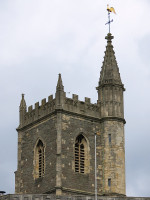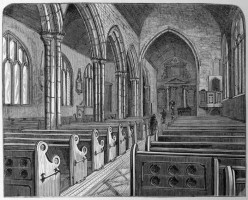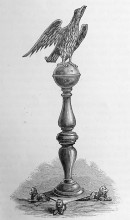 St Mary le Port tower, 15th Century.
St Mary le Port tower, 15th Century.
 St Mary le Port tower, 15th Century.
St Mary le Port tower, 15th Century.
Only the tower of St Mary-le-Port survives, and a few low ruins, but once it was a broad church of nave and two aisles separated by clustered pillars, a high ceiling, though no clerestorey, and furnished with ranked pews and with monuments on the walls. This was the second church, dating from the 15th Century, the previous one being founded in or before 1170, and at one time belonging to the Austin Canons (Augustinian) of the Abbey of Keynsham, south of the Avon. Excavations suggest that there may have been a Saxon church there previously, which would make this Bristol’s earliest church. It was destroyed in the Blitz.
The surviving tower is readily seen from a distance, but is quite hard to approach, being enfolded by a particularly unlovely bank building of the 1960s. The tower, three storeys high, has upon it a small spire, and in the fashion of churches of this part of England, this spire is above the stairwell at one corner.
One historic account of the Church mentions in passing that ‘the monuments, epitaphs and altar are worthy of notice.’ The engraving here, from Bristol Past and Present, 1881, shows two monuments on the wall, one of which is an obelisk monument partially concealed behind the pillar on the left, and the other something Baroque. The eagle lectern is also visible, at the far end near the chancel, and to the right, the pulpit. That eagle lectern was one of the treasures of the Church, tempus Charles II and weighing nearly 700lb, bought from the Cathedral in 1802. The engraving at the bottom of this page shows it to have had little carved lions at the feet (you will need to click to enlarge to see them properly) - unlike the case had they been at the top, symbolically these are bad lions, representations of evil demons being stood upon by the holy font.
Interior view, from Bristol Past and Present, 1881. 
The surviving ruins consist of a few low walls, much concealed by ivy and other plants, and fenced off in part. Near the tower they are taller, and we see a buttress and the remains of a door. The tower at least is in a state of good preservation, and has Perp windows at each of the stages, and battlements on top which are likely 19th Century replacements; the tall pinnacle has weathered gargoyles upon it, and leafy crocketing; at the summit is a modern windvane in the form of a cockerel.
 The Eagle Lectern, formerly belonging to the Cathedral.
The Eagle Lectern, formerly belonging to the Cathedral.
Close by, also in Castle Park, are the much more complete ruins of St Peter Church – see this page.
Temple Church, another Bristol ruin // Christ Church with St Ewen // St Stephen's Church // Statues along Broad Quay, Bristol
Sculpture in England // Introduction to church monuments
Visits to this page from 11 Mar 2015: 4,882